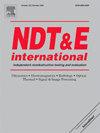Visualization of hidden cracks under corrosion layer in steel structures via eddy current pulsed thermography: Simulation and experiment
IF 4.1
2区 材料科学
Q1 MATERIALS SCIENCE, CHARACTERIZATION & TESTING
引用次数: 0
Abstract
Cracks in steel structures are usually covered by corrosion material and become a hidden hazard to the safety of the structures. It is significantly hard to detect this kind of hidden cracks because of the serious interference form the corrosion layer. This study aims to evaluate the effectiveness of eddy current pulsed thermography (ECPT) in visualizing such hidden cracks and to conduct an in-depth investigation into the inspection mechanism. A simulation model is constructed to analyze electromagnetic and thermal response in the inspected object, which helps to determine the specific thermal features caused by hidden cracks and to clarify the inspection mechanism. Experiments were implemented to verify the effectiveness of ECPT and to confirm thermal features caused by hidden cracks at the inspected surface. Simulation and experimental results show that specific thermal features caused by hidden cracks provide a means of recognizing the hidden cracks from the inspection results. Experimental results also verify that ECPT presents good applicability for specimens with various corrosion severity and for cracks with various orientations. Without need of additional preprocessing of the corroded surface, this work provides a non-contact, instant and intuitive way to visualize the hidden cracks covered by corrosion in steel structures.
求助全文
约1分钟内获得全文
求助全文
来源期刊

Ndt & E International
工程技术-材料科学:表征与测试
CiteScore
7.20
自引率
9.50%
发文量
121
审稿时长
55 days
期刊介绍:
NDT&E international publishes peer-reviewed results of original research and development in all categories of the fields of nondestructive testing and evaluation including ultrasonics, electromagnetics, radiography, optical and thermal methods. In addition to traditional NDE topics, the emerging technology area of inspection of civil structures and materials is also emphasized. The journal publishes original papers on research and development of new inspection techniques and methods, as well as on novel and innovative applications of established methods. Papers on NDE sensors and their applications both for inspection and process control, as well as papers describing novel NDE systems for structural health monitoring and their performance in industrial settings are also considered. Other regular features include international news, new equipment and a calendar of forthcoming worldwide meetings. This journal is listed in Current Contents.
 求助内容:
求助内容: 应助结果提醒方式:
应助结果提醒方式:


